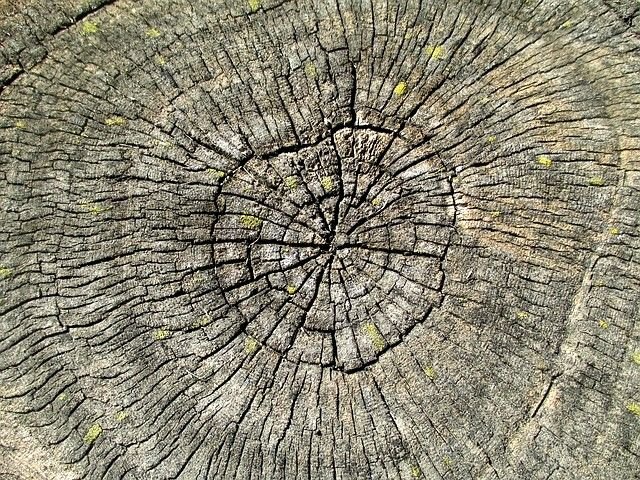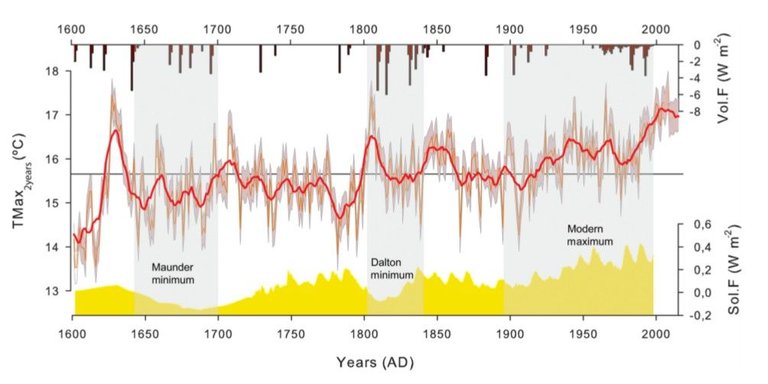The trees speak to us and the stories they tell us are very valuable to understand our past.
The observation of the growth rings of the trees, besides giving us an approximate idea of the age of the tree. It allows us to look to the past and discover what the environmental conditions were during the life of that tree.
1 - Image of the growth rings of a tree. - Pixabay CC0
Tree rings are affected in their growth by environmental factors such as temperature, precipitation and the concentration of gases that make up the atmosphere around the tree itself from which the study sample is extracted.
Normally the climatologists of the past (paleoclimatologists), have historically used the isotopes of some gases trapped in the ice, to study the conditions in terms of temperature and atmospheric composition. This method has allowed us to study the Earth's climate for thousands of years. We have also studied the sediments of the bottom of some lakes, seas, or oceans that have allowed us to know the climate in the different geological eras. Thanks to the collection of these data, famous models such as GISP2 have been developed. In which we can observe the climatic variation in the last millennia.
But unfortunately every time someone uses the Greenland Ice Sheet Project (GISP) data to demonstrate the thermal variation of the Earth, they run into serious problems of being accused of pseudo-science.
For this reason today we are going to use another proxy to obtain climatic data from the past. This proxy is offered by dendrochronology (tree rings).
This field of study has been very important in understanding climatic variation in regions that have historically been free of ice. Giving tools to the paleoclimatologists of those regions to elaborate databases of the climate of the past.
One of these papers was published in 2017, in which we can observe the changes in the temperature of a mountainous region in the center of the Iberian Peninsula (The Iberian Peninsula is composed of two states, Spain and Portugal). In this case to be more precise we will talk about the thermal variation of the Iberian Range.
”The new IR2Tmax reconstruction is spatially representative for the Iberian Peninsula and captures the full range of past Iberian Range temperature variability. Reconstructed long-term temperature variations match reasonably well with solar irradiance changes since warm and cold phases correspond with high and low solar activity, respectively. In addition, some annual temperature downturns coincide with volcanic eruptions with a 3-year lag.”
Q1 - E. Tejedor et. al (2017)
In this quote we can see a direct relationship between solar irradiance and temperature.
Perhaps this isn’t something that anyone who supports the theories of global warming wants to hear. But the truth is that as I said in previous articles, every day more groups of scientists who study the climate through different proxies end up offering the same results.
1 - Temperature variability in the Iberian Range since 1600. - E. Tejedor et. al (2017)
Going down in black we see the volcanic activity, the line that occupies the central part of the graph indicates the temperature and in the lower part we can see the solar irradiance.
In this graph that offers us the study of the rings of trees, the first thing we see without the need to analyze in depth is that the climate isn’t stable. Therefore, the graphs that led Al Gore to win the Nobel Prize are erroneous. Since in these tables a null variation is offered until the industrial revolution followed by an abrupt increase (I am referring to the famous "hockey stick" chart).
Changes in Earth's climate have been occurring since its formation millions of years ago. Those changes have happened naturally. Would anyone think to blame the trilobites for changes in the climate of the Paleozoic Era? Obviously not. But, we can’t blame homo sapiens for climate changes in that Era either, simply because 540 million years ago mammals didn't yet exist.
For me, it is common sense to think that within our solar system there is something that has enough power to change the climate, not only of this planet but of all the others. That something is so big that to fill it, we would have to put one million three hundred thousand Earth-sized planets inside it.
That source of immense power is our star, what we call the Sun. The main cause of the enormous variability in the climate of the Earth since its formation, and that will continue to be the main cause of climate changes in the future, whether man exists or not.
References
`Q1, 2 - “Temperature variability in the Iberian Range since 1602 inferred from tree-ring records” E. Tejedor et al. 2017
https://doi.org/10.5194/cp-13-93-2017
1 - Dendrochronology
https://pixabay.com/es/dendrocronolog%C3%ADa-arbol-anillos-684085/

Gift-thanks to @markperandin
Let's take care of the pale blue dot
Enjoy your day. Enjoy your life.

Gift-thanks to @stellabelle


Information worthy of appreciation
Paleoclimatic data are very similar, either from ice or sediment samples, or as in this paper that uses trees as a proxy.
Thank you very much.
My area had record hours below freezing. But, I guess that isn't climate anymore.
Nah, it's just weather, Lol.
They can call it what they want, but this winter will be the coldest in years, in most regions of the world, we will be breaking cold records , etc.
Además de la edad del árbol, se pueden medir otros parámetros. Los niveles de gases en la atmósfera, la temperatura, etc.
Con esos datos se estudia el clima de la zona y se realizan gráficas del clima del pasado.